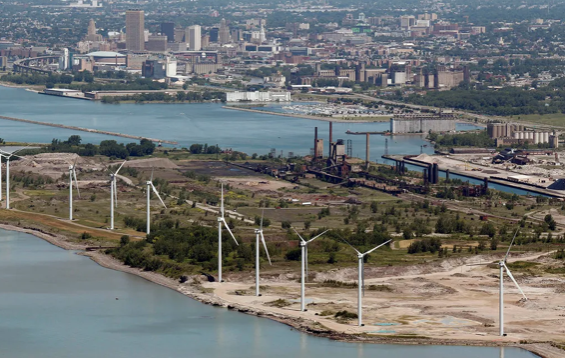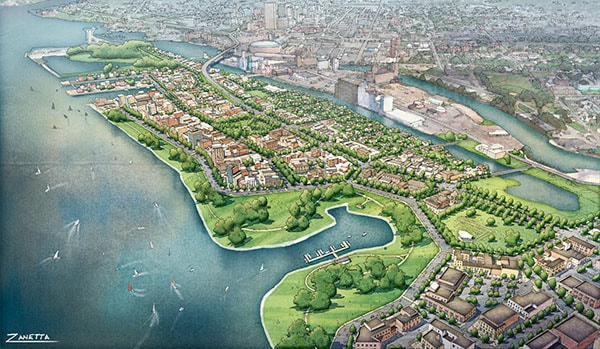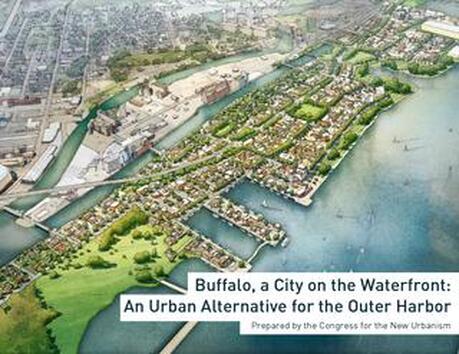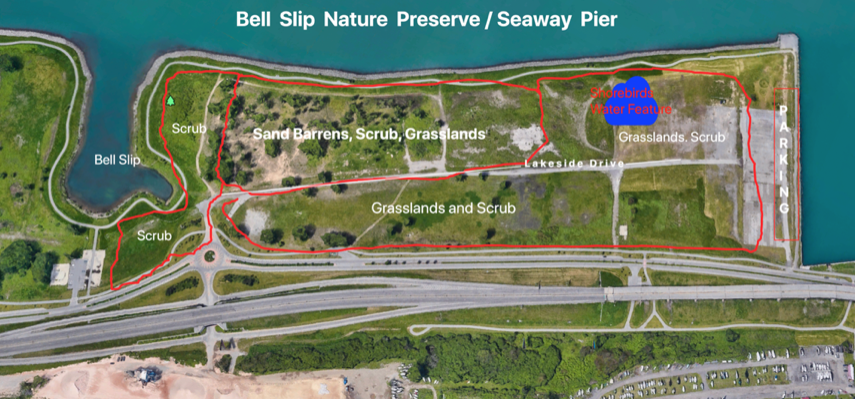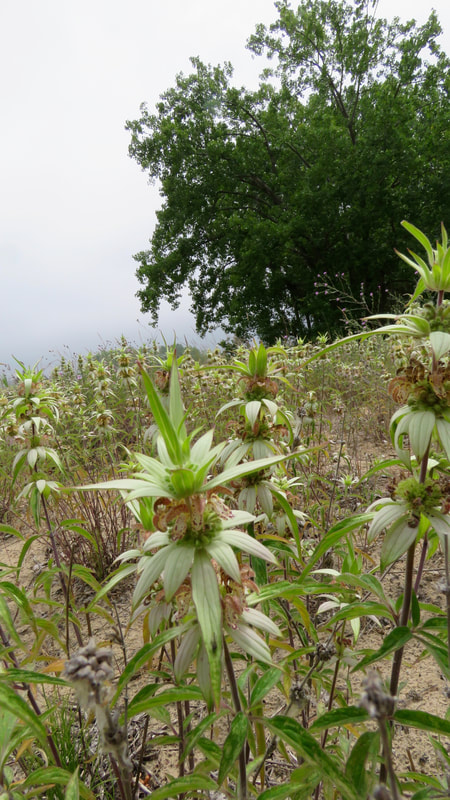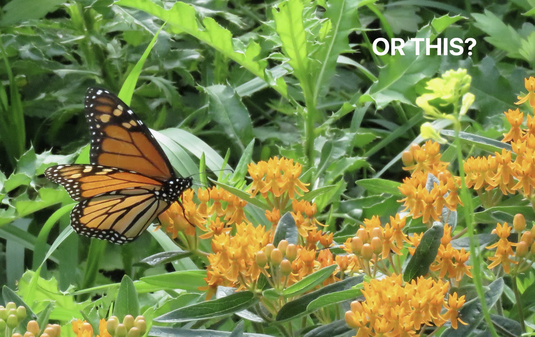WNYEA's DECADE OF BIODIVERSITY
Preamble: Earth is a Rare Paradise
As far as we know, our home planet which is the place that has allowed all life including human life to evolve, may be unique in the universe. Earth’s fundamental life support system is based in the biodiverse life forms that help to create abundant clean air, water, and food. As we continue to evolve as a species, it is increasingly clear that we must find ways to nurture nature, even as it nurtures us.
If we are to survive as a species, we must become better stewards of our environment and better stewards of our rare paradise.
In June of 2021 the Board of the Western New York Environmental Alliance decided to declare the beginning of the “Decade of Biodiversity”.
There are a number of reasons for this. Most of earth’s natural systems are in steep decline. Many scientists characterize these times as part of the Sixth Great Extinction episode.
Climate change is hitting our communities, continents and oceans like a red hot sledge hammer. As global populations continue to grow, human well-being and health are fundamentally affected. As we try to envision and plan for a sustainable and resilient future, we need to weave together actions that understand the relationships between economy, social justice, and the environment.
The rapid decline of natural biodiversity means that the environment has to be the bottom line for a sustainable and resilient future. We therefore pledge that we will lift up the concept of conserving, restoring, and educating about the critical nature of biodiversity because without this, our paradise will vanish.
If we are to survive as a species, we must become better stewards of our environment and better stewards of our rare paradise.
In June of 2021 the Board of the Western New York Environmental Alliance decided to declare the beginning of the “Decade of Biodiversity”.
There are a number of reasons for this. Most of earth’s natural systems are in steep decline. Many scientists characterize these times as part of the Sixth Great Extinction episode.
Climate change is hitting our communities, continents and oceans like a red hot sledge hammer. As global populations continue to grow, human well-being and health are fundamentally affected. As we try to envision and plan for a sustainable and resilient future, we need to weave together actions that understand the relationships between economy, social justice, and the environment.
The rapid decline of natural biodiversity means that the environment has to be the bottom line for a sustainable and resilient future. We therefore pledge that we will lift up the concept of conserving, restoring, and educating about the critical nature of biodiversity because without this, our paradise will vanish.
Where are We in 2021?
For Centuries humans have been at war with nature. Certainly there have been cultures and philosophies throughout the eons that reflect an attempt at harmony and living within a certain biological framework. But the predominant framework has been fight, eliminate, conquer, Today as we move through the first quarter of the 22nd century humans have all but accomplished the final goals.
The earth has been harvested, conquered, abused, tortured and emaciated by a single species that seems to have had those primary intentions. Our future has been stolen, poisoned for profit, and brought to its knees by both ignorance and deliberate malfeasance. This may seem harsh, but so is humanity’s future.
According to Doug Tallamy, the USA has eliminated over 95% of nature, natural systems, and naturally evolved land and waterscapes. Our country has been logged, tilled, drained, grazed, paved, or otherwise developed. Our Rivers have been straightened and damned. Our air has been polluted, our aquifers drained and poisoned, and our climate has been changed for centuries to come. We have purposefully imported thousands of species of plants, insects, and diseases from other lands which have decimated native plant communities on which local food webs depend. We have carved the natural world into tiny remnants, each too small and too isolated to support the variety of species required to sustain the ecosystems that support us. Biodiversity is vanished.
Unfortunately this is a miscalculation that points to the limits of our species ability to think through to an end game that guarantees our ability to peacefully coexist with a planet that has given us life, that nurtures and protects us, that is in the most genuine and accurate way, our mother and our father.
Today, as we charge fully into what science tells us is the 6th major extinction episode on planet earth, we are on the precipice of human extinction. One has to look no further than the viral epidemic that has our species in it’s death clutches to realize how fragile our individual and collective existence is.
Our economic systems have failed us by putting profit ahead of biology and balance. Our cultural resources have failed us by being both myopic and fear based. We live in a diversity of cultures that seem to grow in a test tube of aggression and hatred.
Yet we have love and compassion. We can find those essential values if we look deeply and commit to a different path. There is hope. We know that there is hope. We know that we can find love and compassion for our huan brothers and sisters and our companions that make up the natural world that surrounds us and can sustain us. It is not too late to turn it around and to resuscitate the mother father patient that supports all life, including ours.
That patient, the biological earth, is a rare paradise. As far as we know, we live on a place that is unique in the universe. Just the right conditions of energy, temperature, and biological forces including water and atmosphere have evolved to protect and sustain our species. Life has evolved here in many wondrous and some might say miraculous forms. There is beauty, mystery, and hope here. And our species is at the tip of the spear.
One should argue that humans have a mind that can give us a chance.
We can do better, and we will.
The earth has been harvested, conquered, abused, tortured and emaciated by a single species that seems to have had those primary intentions. Our future has been stolen, poisoned for profit, and brought to its knees by both ignorance and deliberate malfeasance. This may seem harsh, but so is humanity’s future.
According to Doug Tallamy, the USA has eliminated over 95% of nature, natural systems, and naturally evolved land and waterscapes. Our country has been logged, tilled, drained, grazed, paved, or otherwise developed. Our Rivers have been straightened and damned. Our air has been polluted, our aquifers drained and poisoned, and our climate has been changed for centuries to come. We have purposefully imported thousands of species of plants, insects, and diseases from other lands which have decimated native plant communities on which local food webs depend. We have carved the natural world into tiny remnants, each too small and too isolated to support the variety of species required to sustain the ecosystems that support us. Biodiversity is vanished.
Unfortunately this is a miscalculation that points to the limits of our species ability to think through to an end game that guarantees our ability to peacefully coexist with a planet that has given us life, that nurtures and protects us, that is in the most genuine and accurate way, our mother and our father.
Today, as we charge fully into what science tells us is the 6th major extinction episode on planet earth, we are on the precipice of human extinction. One has to look no further than the viral epidemic that has our species in it’s death clutches to realize how fragile our individual and collective existence is.
Our economic systems have failed us by putting profit ahead of biology and balance. Our cultural resources have failed us by being both myopic and fear based. We live in a diversity of cultures that seem to grow in a test tube of aggression and hatred.
Yet we have love and compassion. We can find those essential values if we look deeply and commit to a different path. There is hope. We know that there is hope. We know that we can find love and compassion for our huan brothers and sisters and our companions that make up the natural world that surrounds us and can sustain us. It is not too late to turn it around and to resuscitate the mother father patient that supports all life, including ours.
That patient, the biological earth, is a rare paradise. As far as we know, we live on a place that is unique in the universe. Just the right conditions of energy, temperature, and biological forces including water and atmosphere have evolved to protect and sustain our species. Life has evolved here in many wondrous and some might say miraculous forms. There is beauty, mystery, and hope here. And our species is at the tip of the spear.
One should argue that humans have a mind that can give us a chance.
We can do better, and we will.
Creating Resliency in the International Niagara Region
Buffalo's Outer Harbor, which is a focus of the Western New York Environmental Alliance through the Our Outer Harbor Coalition is a part of the international Niagara River strait ecosystem. This ecosystem is part of a critical bioregion that connects much of North America's watersheds, the Great Lakes (which contain 1/5 of the earth's fresh surface water) from the center of the continent, through the Niagara, and on to the Atlantic Ocean. Much of the water in the Great Lakes flows through the Niagara. Wildlife and biodiversity follow that course which is what makes this region one of the most biodiverse on the planet. The Niagara River region has been declared a "Globally Significant Important Bird Area" and a Ramsar Wetland of International Importance. We share those designations with places like the Galapagos, Yellowstone, and the Everglades.
Buffalo's Outer Harbor is the Gateway to the Niagara River Globally Significant Important Bird Area and is included in the Ramsar Wetland Designation
What Does a Resilient Niagara Region Look Like?
The Niagara River Greenway and the Canadian shorelines should be be designed and developed from a resiliency perspective. Targeted resiliency contexts should guide development in critical areas including Buffalo’s Outer Harbor and the Niagara River Greenway and its associated watersheds.
The concept and characterization of resiliency can be interchanged with that of sustainability. This means that resiliency has to embrace social, economic, and environmental foundations, -with environment being the bottom line. This means that quality of life for future generations, including economic and social resiliency, balances on the fulcrum of environmental and ecological integrity.
The concept and characterization of resiliency can be interchanged with that of sustainability. This means that resiliency has to embrace social, economic, and environmental foundations, -with environment being the bottom line. This means that quality of life for future generations, including economic and social resiliency, balances on the fulcrum of environmental and ecological integrity.
|
Social Resiliency
Social and Economic Justice are issues that are closely linked. There is a strong social justice component to how we view, invest in, and use spaces and property. Unfortunately the message of “best use” is often controlled by the loudest voices. True public benefit is often obscured by wealthy power brokers that control the message and the media. They often have narrow self -interests associated with profit through the extraction local dollars. Often the impacts of this profit do not recognize “external” economic factors including ecological and social damage and costs. These costs are linked to human health and well-being, poverty, and of course politics. David Suzuki calls this conventional economic policy, a form of brain damage. He explained this when he visited Buffalo during the Learning Sustainability Conference. Here is a short video that explains this message: |
|
The Niagara River Greenway includes Buffalo’s Outer Harbor, lake and river shorelines, and broadens into understanding the use of the entire watershed including headwater areas. Essentially this means that we must consider the broad social impact of the use of and the access to these places. For example, the Our Outer Harbor Coalition early on adopted the fundamental principle that public land must remain public. This message resonated with the public and as of this date, land that was intended to be privatized by public owners, remains in public hands. The public must have an educated and informed voice in development and land use decisions. Transparency must underlie decision making. Education about the bottom line ecological values of a place must always take front and center in land use discussions. We must find ways to have transparent political discussions and decision making. This has to involve inclusion and participation the broadest range of individuals and social groups. This has to be a fundamental part of land use discussions. This is an essential resiliency concept. Social benefit comes from both the sharing of critical places and a transparent evaluation of how land use effects health and well-being of human quality of life. Economic benefit comes from responsible use that includes impact on local economic conditions. Public land use must not embrace extractive economic strategies.
Recognizing essential ecological services that promote clean water, clean air, and biodiversity, are important conservation, economic, and social contexts.
The public must be defined in the broadest cultural sense. There must be rule-making and management structures that ensure that the least harm is done to the resiliency of the area. This will always remain a challenge.
Public opinion is often set by those with the loudest voices. We compete in a market place of ideas that is often set by the agenda of big business concerns and voiced by for-profit media outlets that stake their existence on delivering messaging that is often paid for propaganda but businesses that are designed to make money which often means picking the public pocketbook.
Recognizing essential ecological services that promote clean water, clean air, and biodiversity, are important conservation, economic, and social contexts.
The public must be defined in the broadest cultural sense. There must be rule-making and management structures that ensure that the least harm is done to the resiliency of the area. This will always remain a challenge.
Public opinion is often set by those with the loudest voices. We compete in a market place of ideas that is often set by the agenda of big business concerns and voiced by for-profit media outlets that stake their existence on delivering messaging that is often paid for propaganda but businesses that are designed to make money which often means picking the public pocketbook.
Economic Resiliency
There are a number of factors to consider with Economic Resiliency. Currently most of our arguments for appropriate economic use on Buffalo’s outer harbor focus on development, and or business use that is “water dependent”. While there is some merit to that argument, in 2021 this has become outdated. What exactly does “water dependent” mean? Currently it means “use by business or commercial interests that needs access to the water”. It is easy to think that this simply means boatyards and recreational services. It also means industrial and commercial uses that either depend on water access, or are made more cost effective or profitable by water access. This does not usually measure “externality” factors such as environmental or social consequences. This can be a complicated equation. The oversimplified definition often leads to exploitation of public resources including public investments for private gain. That private gain is mostly derived by business that have political connections, often characterized by investments in elected officials. (Queen City Landing). This general context can be applied to many development scenarios throughout the greenway and its associated watersheds.
One of the things that we have to realize is that water, and water access, is one of the most valuable assets of our region and our community. When applied to contemporary economic development and growth models, it is easy to connect the dots to private exploitation opportunities that are not unlike the oil based and consumption based economics. Current models focus on global, regional, or national GDP production. The Great Lakes represent 21% of the world’s fresh surface water. That should continue to be an eye-opener and a call to arms to those that want to protect the resources that make us whole.
One of the things that we have learned is that if our region is to become a strong and or sustainable economic power, we need to create and support a “local economy” that retains the local value, and therefore the local protection of resources. There is of course a regional perspective that accounts for shared resources. We have to acknowledge that exploitation and economic extraction by non-local interests has both destructive results and economic development model that has substantial “externality” impacts and consequences on society and the environment.
This is why the 2001 Learning Sustainability Conference held in Buffalo was subtitled “Learning to Think Like a Region in a Globalized World.” Building a resilient local economy that keeps money local, is a key to protecting the quality of life for future generations.
There are a number of factors to consider with Economic Resiliency. Currently most of our arguments for appropriate economic use on Buffalo’s outer harbor focus on development, and or business use that is “water dependent”. While there is some merit to that argument, in 2021 this has become outdated. What exactly does “water dependent” mean? Currently it means “use by business or commercial interests that needs access to the water”. It is easy to think that this simply means boatyards and recreational services. It also means industrial and commercial uses that either depend on water access, or are made more cost effective or profitable by water access. This does not usually measure “externality” factors such as environmental or social consequences. This can be a complicated equation. The oversimplified definition often leads to exploitation of public resources including public investments for private gain. That private gain is mostly derived by business that have political connections, often characterized by investments in elected officials. (Queen City Landing). This general context can be applied to many development scenarios throughout the greenway and its associated watersheds.
One of the things that we have to realize is that water, and water access, is one of the most valuable assets of our region and our community. When applied to contemporary economic development and growth models, it is easy to connect the dots to private exploitation opportunities that are not unlike the oil based and consumption based economics. Current models focus on global, regional, or national GDP production. The Great Lakes represent 21% of the world’s fresh surface water. That should continue to be an eye-opener and a call to arms to those that want to protect the resources that make us whole.
One of the things that we have learned is that if our region is to become a strong and or sustainable economic power, we need to create and support a “local economy” that retains the local value, and therefore the local protection of resources. There is of course a regional perspective that accounts for shared resources. We have to acknowledge that exploitation and economic extraction by non-local interests has both destructive results and economic development model that has substantial “externality” impacts and consequences on society and the environment.
This is why the 2001 Learning Sustainability Conference held in Buffalo was subtitled “Learning to Think Like a Region in a Globalized World.” Building a resilient local economy that keeps money local, is a key to protecting the quality of life for future generations.
Environmental and Ecological Resiliency
Biodiversity and ecological integrity are the foundation of all life including human life.
Nature is a partner to humans. We must learn how to work in partnership. We can no longer afford to treat nature as an adversary to be conquered. As Lester Milbrath explained, “Nature always bats last”. Paul Reitan put it this way: “A sustainable society is one that functions and lives in such harmony with earth systems that future generations will be able to function with equal or greater ease and the quality of life will in no way be diminished.”
We have built upon this discussion with our work including our planning, our organization and movement building, and with our hearts and feet.
Looking at the Outer Harbor as a barrier island both promotes a resilient ecological context, and a substantial economic and social foundation for a resilient and sustainable future for all people.
From an economic perspective, we can lead with the argument that climate change and increasingly powerful, unpredictable, and frequent storms, combined with historic high water levels, is a force that we may not be able to recon with. We have to rethink the kinds of engineering fundamentals that have long been embraced by the USACE such as walled and armored coastlines, shorelines, and to an extant harbors. Certainly the economic damages and the potential social consequences including loss of life, inflicted upon communities such as Buffalo are going to increase. Just since last October the physical damages to our breakwalls, and places like Times Beach Nature Preserve, LaSalle Park (aka Ralph Wilson Centennial Park), Hoover Beach, Sturgeon Point, and shoreline communities stretching west to the New York border and beyond, and to shoreline communities along the Niagara River Strait and throughout Lake Ontario require some rethinking. Time to reboot. Time to argue for making common sense decisions and investments that focus on resiliency.
A barrier island concept for the outer harbor can be a fundamental strategy for the future. Creating green areas that help nature's intentions can prevent nature from taking places like Buffalo and turning them into disaster zones. Importantly, green areas on the Outer Harbor can be positive quality of life recreational areas for humans in the good times, and provide life saving ecological services in the increasingly frequent bad times.
Biodiversity and ecological integrity are the foundation of all life including human life.
Nature is a partner to humans. We must learn how to work in partnership. We can no longer afford to treat nature as an adversary to be conquered. As Lester Milbrath explained, “Nature always bats last”. Paul Reitan put it this way: “A sustainable society is one that functions and lives in such harmony with earth systems that future generations will be able to function with equal or greater ease and the quality of life will in no way be diminished.”
We have built upon this discussion with our work including our planning, our organization and movement building, and with our hearts and feet.
Looking at the Outer Harbor as a barrier island both promotes a resilient ecological context, and a substantial economic and social foundation for a resilient and sustainable future for all people.
From an economic perspective, we can lead with the argument that climate change and increasingly powerful, unpredictable, and frequent storms, combined with historic high water levels, is a force that we may not be able to recon with. We have to rethink the kinds of engineering fundamentals that have long been embraced by the USACE such as walled and armored coastlines, shorelines, and to an extant harbors. Certainly the economic damages and the potential social consequences including loss of life, inflicted upon communities such as Buffalo are going to increase. Just since last October the physical damages to our breakwalls, and places like Times Beach Nature Preserve, LaSalle Park (aka Ralph Wilson Centennial Park), Hoover Beach, Sturgeon Point, and shoreline communities stretching west to the New York border and beyond, and to shoreline communities along the Niagara River Strait and throughout Lake Ontario require some rethinking. Time to reboot. Time to argue for making common sense decisions and investments that focus on resiliency.
A barrier island concept for the outer harbor can be a fundamental strategy for the future. Creating green areas that help nature's intentions can prevent nature from taking places like Buffalo and turning them into disaster zones. Importantly, green areas on the Outer Harbor can be positive quality of life recreational areas for humans in the good times, and provide life saving ecological services in the increasingly frequent bad times.
How to do this?
It is critical to define the Outer Harbor as part of a larger entity. Geographically, our outer harbor connects to a larger regional shoreline, offshore, and inland that includes international communities, watersheds, the Niagara River strait, the Buffalo River, and places like Smokes Creek. (Margaret Wooster map)
Current plans to take down the skyway, relocate substantial roadways (including into Tifft Nature Preserve), bring a large concert venue with its chaotic traffic and parking consequences, and to open up private development opportunities on the outer harbor will have horrible consequences on the design, building, and maintenance of a resilient community and outer harbor. We must characterize and define the impacts and consequences of inappropriate development in areas such as Tifft Nature Preserve, the Union Ship Canal, the Lakeside Industrial Park, The Shoreline Trail, and the approach to the former Bethlehem Steel site by Erie County, SUNY Buffalo, and New York State. This modeling should be considered throughout the Niagara River region and its important shorelines.
We can and must build on assets and temporary development victories that we have won with Erie Canal harbor Development Corporation (A public funded subsidiary of the Empire Development Corporation (ECHDC) and other public and private entities such as the Queen City Landing Project, a private glass condo tower that was planned on the Outer Harbor.
Shoreline Trail: https://www2.erie.gov/environment/index.php?q=shoreline-trail
It is critical to define the Outer Harbor as part of a larger entity. Geographically, our outer harbor connects to a larger regional shoreline, offshore, and inland that includes international communities, watersheds, the Niagara River strait, the Buffalo River, and places like Smokes Creek. (Margaret Wooster map)
Current plans to take down the skyway, relocate substantial roadways (including into Tifft Nature Preserve), bring a large concert venue with its chaotic traffic and parking consequences, and to open up private development opportunities on the outer harbor will have horrible consequences on the design, building, and maintenance of a resilient community and outer harbor. We must characterize and define the impacts and consequences of inappropriate development in areas such as Tifft Nature Preserve, the Union Ship Canal, the Lakeside Industrial Park, The Shoreline Trail, and the approach to the former Bethlehem Steel site by Erie County, SUNY Buffalo, and New York State. This modeling should be considered throughout the Niagara River region and its important shorelines.
We can and must build on assets and temporary development victories that we have won with Erie Canal harbor Development Corporation (A public funded subsidiary of the Empire Development Corporation (ECHDC) and other public and private entities such as the Queen City Landing Project, a private glass condo tower that was planned on the Outer Harbor.
Shoreline Trail: https://www2.erie.gov/environment/index.php?q=shoreline-trail
A Definition of "Appropriate Development"
What is appropriate development in a resiliency and sustainability context?
-Protects and conserves ecology and environment, clean water, clean air, and biodiversity.
-Improves ecological and environmental resources.
-Provides substantial, transparent, and accountable public benefit now and for future generations, socially, economically, and environmentally. (Including a transparent public vetting process including public meetings and hearings)
-Recognizes, protects, preserves cultural and historic resources.
-Creates measurable and transparent public economic benefit.
-Protects and conserves ecology and environment, clean water, clean air, and biodiversity.
-Improves ecological and environmental resources.
-Provides substantial, transparent, and accountable public benefit now and for future generations, socially, economically, and environmentally. (Including a transparent public vetting process including public meetings and hearings)
-Recognizes, protects, preserves cultural and historic resources.
-Creates measurable and transparent public economic benefit.
|
Do You Want This?
|
Or This?
|
